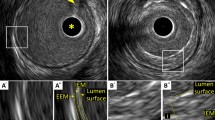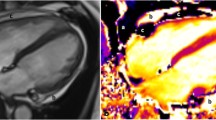Abstract
Purpose
Minimally invasive aortic valve replacement (MIAVR) procedures remain more complex and technically challenging compared to conventional full sternotomy surgery. This technique involves a restricted surgical field and a limited workspace, which is, at present, strictly reserved for the most experienced surgeons. The MIAVR clinical outcomes are strongly dependent on the appropriate choice of the thoracic incision. This work presents a decision support system to optimize, through an interactive visualization interface, the exposure of the target structure in a limited field of view.
Methods
Our approach is based on the computation of relevant anatomical measurements from preoperative CT images, and it takes into account the surgical guidelines in order to propose the surgical access that best fits the patient’s morphology.
Results
The proposed planning system was applied and tested on 30 datasets from patients affected by severe aortic stenosis for validation purposes. We evaluated the accuracy of the automatic detections and the measurements calculated by the system with those chosen manually by the expert.
Conclusions
In 87% of thirty cases, the surgical strategy proposed by the decision support system was correct. For the remaining cases, the graphical user interface (GUI) allowed the user to manually adjust the anatomical features.










Similar content being viewed by others
References
Walther T, Falk V, Mohr FW (2006) Minimally invasive surgery for valve disease. Curr Probl Cardiol 31(6):399–437
Glauber M, Ferrarini M, Miceli A (2015) Minimally invasive aortic valve surgery: state of the art and future directions. Ann Thorac Surg 4(1):26–32
Moscoso M, Rastan A (2015) Complications and conversions in minimally invasive aortic valve surgery. Ann Cardiothorac Surg 4(1):94–98
Loor G, Roselli E (2015) Imaging and minimally invasive aortic valve replacement. Ann Cardiothorac Surg 4(1):62–66
Ammar R, Porat E, Eisenberg D, Uretzky G (1998) Utility of spiral CT in minimally invasive approach for aortic valve replacement. Eur J Cardiothorac Surg Suppl 1:130–133
Plass A, Scheffel H, Alkadhi H, Kaufmann P, Genoni M, Falk V, Grünenfelder J (2009) Aortic valve replacement through a minimally invasive approach: preoperative planning, surgical technique, and outcome. Ann Thorac Surg 88(6):1851–1856
Totaro P, Morganti S, Paris M, Conti M, Pagani F, Auricchio F (2012) Computational CT-based patient-specific reconstruction of surgical field to optimize minimally invasive cardiac surgery approach. International Society for minimally invasive cardiothoracic surgery. Annual Scientific Meeting, California, USA
Furui M, Oohashi T, Kobayashi Y, Kageyama S, Kimura A (2012) Usefulness of preoperative 3D-reconstructions of CT images for the planning of minimally invasive cardiac surgery (MICS). Innovations 7(2):128–160
Loor G, Desai MY, Roselli E (2013) Pre-operative 3D CT imaging for virtual planning of minimally invasive aortic valve surgery. JACC Cardiovasc Imaging 6(2):269–271
Heuts S, Maessen G, Nia PS (2016) Preoperative planning of left-sided valve surgery with 3D computed tomography reconstruction models: sternotomy or a minimally invasive approach? Interact Cardio Vasc Thorac Surg 22(5):587–593
Elattar M, van Kesteren F, Wiegerinck E, van Davel E, Baan J, Cocchien R, Planken N, Marquering H (2015) Automatic planning of minimally invasive aortic valve replacement surgery. ICIAR, LNCS 9164:536–540
Adams R, Bischof L (1994) Seeded region growing. Pattern analysis and machine intelligence. IEEE Trans Pattern Anal Mach Intell 16:641–647
Selthofer R, Nikolié V, Mreela T, Radié R, Leksan I (2006) Morphometric analysis of the sternum. Coll Antropol 1:43–47
Pazokifard B, Sowmya A (2013) 3-D segmentation of human sternum in lung MDCT images. In: Annual international conference of the IEEE EMBC, vol 2013, pp 3351–3354
Welzl E (1991) Smallest enclosing disks (balls and ellipsoids). In: Maurer H (ed) New results and new trends in computer science. Springer, Berlin, pp 359–370
Boix-Garibo R, Mohsin M, Nilkanth W (2015) Review of minimally invasive aortic valve surgery. Interv Cardiol Rev 10(3):144–145
Miceli A, Lio A, Glauber M (2016) The anterior thoracotomy approach for aortic valve replacement: tips, tricks and our technique. Perspect Cardiothorac Surg SCTS-Ionescu Univ 1(7):95–100
Promayon E, Fouard C, Bailet M, Deram A, Fiard G (2013) Using CamiTK for rapid prototyping of interactive computer assisted medical intervention applications. In: Annual international conference of the IEEE EMBC, pp 4933–4936
Acknowledgements
This work has been partially supported by the LABEX CAMI (Ref. ANR-11-LABX-0004).
Author information
Authors and Affiliations
Corresponding author
Ethics declarations
Conflict of interest
The authors declare that they have no competing interests.
Ethical standard
Anonymous retrospective procedure data were used. For this type of study, formal consent is not required.
Informed consent
For this type of study, informed consent of the participants is not required.
Rights and permissions
About this article
Cite this article
Li, H., Castro, M., Haigron, P. et al. Decision support system for the planning of minimally invasive aortic valve replacement surgery. Int J CARS 13, 1245–1255 (2018). https://doi.org/10.1007/s11548-018-1725-7
Received:
Accepted:
Published:
Issue Date:
DOI: https://doi.org/10.1007/s11548-018-1725-7




